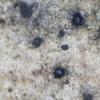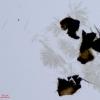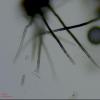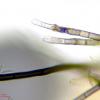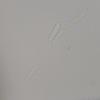
21-12-2025 09:32
Hello.A tiny ascomycete found embedded in wood in

21-12-2025 21:32
Pol DebaenstHello, Garden, Burgweg 19, Veurne, BelgiumOn 10/1

22-12-2025 23:38
Patrice TANCHAUDBonsoir, récolte sur un mur en pierre, apothéci

22-12-2025 00:47
Patrice TANCHAUDBonsoir, récolte à proximité du milieu dunaire

21-12-2025 21:40
Isabelle CharissouBonjour, j'aimerais connaitre les références de

20-12-2025 23:08
Patrice TANCHAUDBonsoir, récolte sur sol sablonneux dans l'arri�
Hairy black on Acer
Margot en Geert Vullings,
02-12-2024 19:02
The hairs are lighter in color towards the top and the top is rounded.
The hairs are multiseptate and double-walled.
The spores have one sept and cilia at both ends.
Measured in water: Me = 15.6 × 2.9 µm ; Qe = 5.3
Does anyone have an idea what this could be?
Many thanks in advance,
Margot&Geert
Martin Bemmann,
02-12-2024 19:40

Re : Hairy black on Acer
Probably a Dinemasporium?
Regards
Martin
Margot en Geert Vullings,
02-12-2024 21:30
Re : Hairy black on Acer
Thanks Martin, that seems to fit well.
Is it possible to come to a specie? We have no idea which species occur in the Netherlands.
Is it possible to come to a specie? We have no idea which species occur in the Netherlands.
Martin Bemmann,
03-12-2024 10:45

Re : Hairy black on Acer
Hi,
a common species, known also from Acer, is D. decipiens. But your measurements of the conidia a far too large. Did you measure with or without the setulae?
Martin
Margot en Geert Vullings,
03-12-2024 17:08
Re : Hairy black on Acer
We measured the conidia without the setulae.
The setulae were measured:
(3.8) 3.9 - 5.6 (6.6) µm
N = 20
The setulae were measured:
(3.8) 3.9 - 5.6 (6.6) µm
N = 20
Me = 4.8 µm
Margot&Geert
Martin Bemmann,
04-12-2024 10:10

Re : Hairy black on Acer
My last guess would be Pseudolachnea hispidula. The size of the conidia would fit, though more slender in Ps.h.. They are one-septate, but the setulae are shorter, 2-3µm (Sutton 1980), 1-1.2 µm (Nag Raj 1993).
Margot en Geert Vullings,
04-12-2024 10:53
Re : Hairy black on Acer
We also looked at Pseudolachnea hispidula, but it has hairs that are not septated and we found multi-septate hairs. We also did not see the white center.
Thomas Flammer,
04-12-2024 13:19
Re : Hairy black on Acer
Margot en Geert Vullings,
05-12-2024 12:04
Re : Hairy black on Acer
Thomas, can Phomatospora dinemasporium also occur on wood?
Described in Ellis&Ellis this is on grasses and other plants.
Kind regards, Margot&Geert
Martin Bemmann,
05-12-2024 16:44

Re : Hairy black on Acer
Hmmm,
sporodochia look quite different, conidia are more slender and non-septate and setulae this time longer...
Margot en Geert Vullings,
05-12-2024 17:30
Re : Hairy black on Acer
Thanks Martin then we will keep this one at P. hispidula.
Kind regards, Margot&Geert
Martin Bemmann,
05-12-2024 18:25

Re : Hairy black on Acer
make it cf....
Margot en Geert Vullings,
06-12-2024 13:35
Re : Hairy black on Acer
Martin, we do not know the meaning of cf, is it uncertain or it does resemble?
Kind regards, Margot&Geert
Martin Bemmann,
06-12-2024 14:15

Re : Hairy black on Acer
cf. is originally the abbrevation for Latin confer = compare!.
In biology it means collectio formarum = a group of similar forms, as a comment to the uncertain ascription to a specific species.
Both interpretations do more or less the same job...
Regards
Martin
Thomas Flammer,
06-12-2024 14:21
Re : Hairy black on Acer
Margot en Geert Vullings,
06-12-2024 19:09
Re : Hairy black on Acer
Thank you Thomas.
